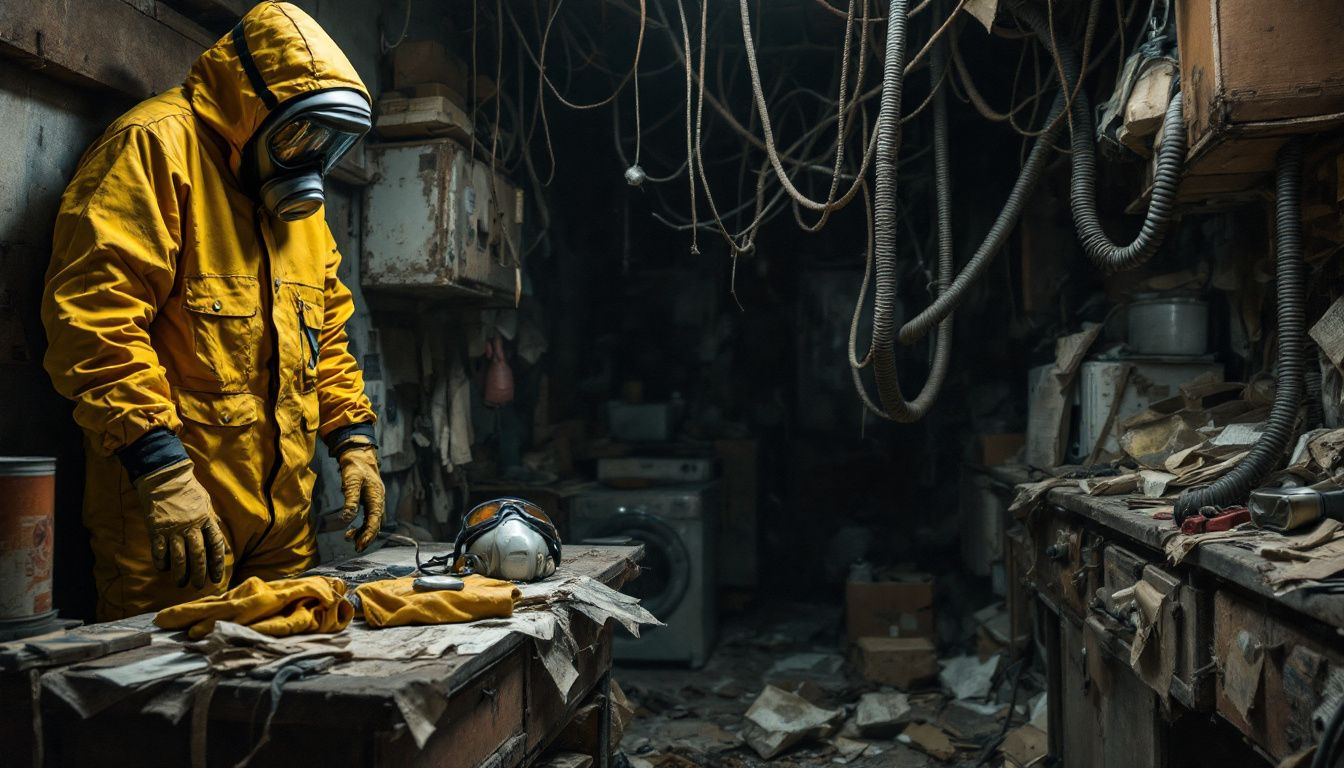dangers of cleaning a hoarders house

Beware the Dangers of Cleaning a Hoarders House: What You Need to Know
The dangers of cleaning a hoarders house are both real and varied. Health risks include exposure to mold, dust, and human waste, while physical injuries from hidden sharp objects are common. In this article, we will delve into these dangers and provide practical advice to ensure a safe cleaning process.
Key Takeaways
Cleaning a hoarder’s house poses significant health risks due to exposure to biohazardous materials, poor air quality, and potential infections from contaminants.
Structural hazards in hoarded homes, including the risk of collapse and fire hazards, necessitate careful assessment and safety measures to prevent injury during cleanup.
Psychological challenges arise during the cleanup process, highlighting the importance of mental health support for both cleaners and family members involved in addressing hoarding behavior.
Health Risks in a Hoarder's House

Individuals tasked with cleaning a hoarder’s home are at risk of encountering various health hazards. The house often contains biohazardous substances including mold, dust, and human and animal waste—all capable of having serious negative effects on one’s health. If someone is exposed to these elements over an extended period, respiratory issues may become aggravated, and intense allergic responses could be provoked. Exposure to dust, mold, and allergens can exacerbate respiratory conditions, worsening pre-existing issues like asthma. Additionally, the impact of dust accumulation on physical well-being is significant, as inhaling dust can lead to respiratory issues and allergic reactions.
The existence of hazardous biological materials such as human excrement increases the possibility of contracting illnesses like gastroenteritis along with other infections.
As individuals embark on clearing out a hoarder’s dwelling:
They must contend with potentially harmful materials like mold spores and airborne particulates.
There is the issue of coming into contact with waste from both humans and animals.
Individuals face an increased likelihood that any present respiratory conditions might worsen due to prolonged exposure.
Allergic reactions can range from moderate to severe in response to accumulated allergens.
Owing to biohazards within this environment there exists a greater chance for digestive system-related diseases among others caused by infectious agents.
The disordered state in which these houses are kept means sharp items can easily go unnoticed—this presents additional physical injury risks amid clean-up operations. Unsanitary living spaces often attract vermin, thus creating extra vectors for disease transmission. It’s important that those undertaking the task of restoring cleanliness in such homes have full awareness of potential dangers involved therein so they may adequately prepare themselves beforehand.
Respiratory Issues
Substandard air quality inside homes filled with hoarding can pose a major health risk. The accumulation of dust, mold spores, and various airborne pollutants has the potential to spark significant respiratory ailments. Individuals suffering from conditions like asthma or bronchitis may find their symptoms worsened due to the degraded air caused by these contaminants. Mold—which often remains hidden amidst all the clutter—can lead to serious respiratory issues and diseases as people breathe in its spores along with dust particles, potentially causing acute infections of the lungs.
Enhancing ventilation is key in reducing these hazards. By opening windows and doors, one can notably improve indoor air circulation while utilizing air purifiers helps filter out particulates such as dust mites and allergens from the environment. Taking such measures is essential for safeguarding those tasked with clearing out clutters against harm to their pulmonary well-being.
Allergic Reactions
When undertaking the task of cleaning a hoarder’s house, one is often faced with common hazards that can provoke allergic reactions.
These allergens encompass:
Mold
Dust
Pollen
Pet dander
Fungal spores
Such substances are notorious for instigating severe allergies, and mold stands out as a particularly potent allergen for those who have specific sensitivities to it. The substandard air quality typically found in cluttered homes amplifies these allergic reactions.
Being exposed to these irritants over an extended period may result in symptoms like respiratory issues, watery eyes, and nasal discharge. To mitigate this risk and reduce the chances of experiencing allergic reactions, it’s advisable to employ protective measures such as wearing appropriate gear during cleanup operations and incorporating air filters into the environment.
Infections from Biohazards
In the homes of hoarders, there is a substantial concern regarding biohazardous materials. The presence of rotting food, as well as animal and human waste, is typical in such conditions. Coming into direct contact with these substances can have serious health implications due to the risk of severe infections.
The danger of contracting infections increases in environments cluttered with sharp objects and marred by unhygienic circumstances. It’s essential for individuals dealing directly with these hazards to utilize appropriate protective gear and adhere strictly to established safety guidelines to prevent exposure to infectious agents from contaminated sources.
Structural Hazards in Hoarded Homes

The accumulation of items due to hoarding disorder may pose substantial structural risks within the home of an individual who hoards. The heavy load from this accumulated clutter has the potential to weaken a structure’s foundation, which could result in instability and even collapse. During cleanup endeavors, uneven surfaces caused by excessive clutter increase the likelihood of tripping or falling.
Identifying these hazards associated with hoarding is crucial for maintaining safety throughout the process of clearing out such spaces.
Risk of Collapse
Hoarded homes pose a serious threat of structural damage due to the heavy weight of accumulated clutter, which can compromise the building’s structural integrity. In extreme cases, disorganized stacks of items could collapse during an attempt at removal, potentially causing harm or damage to the house if these structural risks are overlooked.
To ensure safety, it is critical to evaluate and continually monitor the home’s structural stability throughout cleaning processes. Weak points should be identified and strengthened as necessary in order to avoid accidents and additional destruction.
Fire Hazards
Initially:
In homes affected by hoarding, fire hazards pose a considerable risk due to the accumulation of flammable materials like outdated newspapers and garments. These items can accelerate the spread of fires, exacerbating control efforts. Environments cluttered with such items create severe fire risks as they can entrap these combustibles while also obstructing escape paths. The congestion caused by excessive clutter could hamper residents from swiftly evacuating in case of a blaze.
Subsequently:
Potential fire threats within excessively stored households include:
Accumulations of flammable matter including ancient periodicals and attire that may quicken the advance of flames.
Environments congested with debris that capture inflammable articles thereby elevating serious incendiary dangers.
Impeded egress routes which might restrict inhabitants’ ability to evacuate amidst an inferno crisis.
The eradication of ignitable substances coupled with guaranteeing unobstructed exit ways addresses issues related to combustion perils, diminishing jeopardy levels and bolstering security for both occupants and those engaged in clearing out spaces.
Trip Hazards and Sharp Objects
The accumulation of clutter on the floor in homes filled with hoarding often leads to trip hazards. The presence of irregular stacks can result in uneven walking surfaces, which amplifies the likelihood of stumbling and falling. Sharp items that are concealed within this disorder carry a considerable threat for injury while performing cleanup activities.
To minimize these dangers, it is imperative to conduct an exhaustive examination and handle objects with caution during the cleanup process. Equipping oneself with appropriate safety attire such as protective gloves and boots is essential to guard against harm from sharp articles hidden among the clutter.
Pest Infestations and Their Dangers

Hoarded residences often face pest outbreaks, which markedly amplify health dangers. Rotting food and decaying matter draw in vermin, escalating the health risks for individuals tasked with cleaning these spaces. The proximity to pests and their droppings significantly elevates the potential for severe allergic reactions by introducing a plethora of allergens, thereby intensifying health hazards associated with infestations.
Vermin Infestation
Hoarder dwellings often suffer from invasions of common pests such as rats, cockroaches, and bedbugs. These nuisances are drawn to the dust and remnants of food available in such homes and find refuge amidst the cluttered environment. The presence of pest excrement and deceased animals exacerbates health dangers within these spaces. Notably, rodents like mice are known carriers of illnesses including Listeria and Salmonella.
To combat these infestations effectively, rigorous cleaning coupled with deliberate pest eradication efforts is imperative. By disposing waste appropriately and upholding a hygienic living space, one can significantly diminish the threat posed by pest proliferation.
Dead Animals
The existence of deceased animals within cluttered dwellings carries substantial health risks. The decay of these animal bodies can contaminate the air and release dangerous pathogens into the surroundings, leading to a significant decline in indoor air quality.
When dealing with dead animals, it is imperative to exercise caution and use appropriate safety gear to avoid contact with dangerous pathogens. Swift elimination and correct disposal of these remains are crucial steps in reducing health hazards.
Pests and Rotting Food
Decomposing food within the confines of a hoarder’s residence is a significant lure for various pests, which can hinder the cleaning efforts and elevate health risks. This decaying matter intensifies pest infestations due to its attraction, thereby complicating the sanitation process while also posing Risks to health.
Ensuring that spoiled food is disposed of correctly and upholding hygienic standards are critical steps in averting pest problems and diminishing potential health hazards. Implementing effective pest control strategies assists in regulating these unwanted inhabitants, contributing to a safer living space.
Psychological and Emotional Challenges

Initiating a cleanup process in an area filled with clutter can elicit intense emotional reactions, which underscores the importance of handling such situations with empathy. The accumulation of objects within a space prone to hoarding can strain interpersonal connections and lead to considerable anguish for both the person struggling with clutter and their close associates.
Understanding the mental and emotional hurdles is key to effectively managing a successful cleanup operation.
Mental Strain on Cleaners
Tackling the cleanup of a hoarder’s home is as much an emotional endeavor as it is a physical one, frequently evoking feelings of anxiety and helplessness due to its daunting nature. The task becomes increasingly challenging in light of the poor indoor air quality and extensive clutter found within the house.
Offering emotional support alongside regular breaks throughout the cleaning process can help reduce psychological stress. It’s crucial to acknowledge and address the significant emotional impact such cleanups entail.
Impact on Family Members
Confronting a relative’s hoarding disorder can impose considerable mental distress on family members. They may experience an intense emotional burden during the cleanup process, dealing with deep-seated problems and difficult choices, often accompanied by feelings of frustration, helplessness, and even resentment.
Seeking support from mental health professionals is crucial for family members to cope with their emotions effectively. This professional assistance not only facilitates a successful resolution of the hoarding issue, but also helps preserve familial bonds throughout the challenging cleanup journey.
Importance of Support
The inclusion of professional expertise is vital to successfully manage the complexities that arise during hoarding cleanup endeavors. It ensures that those participating in the cleanup are equipped with the necessary skills and understanding, leading to a process that is both effective and conducted with sensitivity towards everyone involved.
Having access to resources such as therapists and support groups is instrumental for families dealing with hoarding behaviors. These supports play a critical role in enhancing comprehension of hoarding intricacies and contribute substantially to improving the emotional well-being of all affected individuals.
Protective Measures for Safe Cleanup

To minimize hazards while cleaning a hoarder’s residence, it is vital to adopt safety protocols. This includes wearing suitable personal protective equipment (PPE), securing adequate airflow throughout the space, and contemplating the employment of professional cleaners to guarantee both safe and effective cleanup processes.
Personal Protective Equipment (PPE)
Wearing PPE is crucial to minimize exposure to hazardous materials when cleaning a hoarder’s home. Rubber gloves, breathing masks, goggles, and safety boots provide protection against harmful substances, respiratory hazards, and physical injuries. Coveralls offer a full-body barrier against contaminants.
PPE protects individuals from harmful substances and reduces respiratory issues and infections. Proper use of safety gear is essential for safe cleanup.
Ventilation and Air Quality
Proper ventilation maintains air quality during cleanup. Opening doors and windows allows fresh air to circulate, reducing respiratory problems and enhancing well-being.
Air purifiers further enhance air quality by filtering out dust and allergens, crucial for the health and safety of everyone involved in the cleanup.
Professional Cleaners
Engaging the services of professional cleaners adept in tackling hoarding scenarios is essential to navigate the intricacies involved in sanitizing a hoarder’s residence. These experts are equipped with specialized skills necessary for confronting distinct obstacles, which promotes both safety and efficiency during the cleanup procedure. They offer vital measures like mold remediation and pest management to combat perilous situations.
Such professionals play a critical role in diminishing health risks while ensuring an exhaustive and successful cleaning endeavor. Their knowledge greatly enhances control over various hazards that come with purging a house affected by hoarding behavior.
Summary
Cleaning a hoarder’s house is a challenging and potentially dangerous task. The health risks, structural hazards, pest infestations, and psychological challenges make it a daunting endeavor. Understanding these risks and implementing protective measures are crucial for a successful and safe cleanup.
By wearing appropriate PPE, ensuring proper ventilation, and considering professional cleaners, you can mitigate the dangers and ensure a safer environment. The support of mental health professionals and family members is also essential for managing the emotional toll. With the right knowledge and preparation, cleaning a hoarder’s house can be a manageable task.
Frequently Asked Questions
What are the main health risks associated with cleaning a hoarder's house?
Addressing the cleanup of a hoarder’s house involves facing substantial health dangers, including respiratory problems due to inferior air quality, potential allergic responses from exposure to dust and mold, as well as the risk of infection resulting from biohazardous substances such as animal or human waste.
Undertaking this task necessitates cautious action along with appropriate safety equipment.
How can I protect myself from respiratory problems while cleaning?
To effectively protect yourself from respiratory problems while cleaning, ensure proper ventilation by opening windows and using air purifiers, and always wear appropriate personal protective equipment like masks and goggles.
Taking these precautions can significantly reduce your risk of respiratory issues.
What structural hazards should I be aware of in a hoarder's home?
Be aware of the risk of collapse from excessive weight, fire hazards due to flammable materials and blocked exits, and trip hazards from clutter and hidden sharp objects in a hoarder’s home.
These conditions can pose significant safety risks.
Why is professional help important during the cleanup process?
The expertise of professional help is essential in the cleanup process as they are equipped to tackle unique hoarding-related challenges, including mold remediation and pest control.
Their proficiency in safeguarding against hazards and handling intricate details plays a vital role in realizing a positive result from the cleanup effort.
How can I support a family member with hoarding disorder during the cleanup?
To effectively support a family member with hoarding disorder during the cleanup, provide emotional support and engage professional mental health assistance, while also involving cleanup professionals to ensure a respectful and sensitive approach.
This collaborative effort can create a more compassionate environment for the individual.
Latest news

Nosy neighbors peeking? T.A.C.T. North Atlanta offers discreet biohazard remediation for rodent infestations, mold, hoarding, and more. Unmarked vehicles, quiet experts, full privacy—24/7 service at 470-781-4775.
Read More

